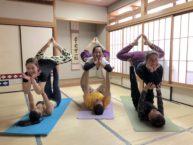I had the chance to assist the staff at Impact Hub Kyoto as my Community Involvement Project this semester.
Impact Hub is a non-profit organization that provides working space for community businesses to utilize and collaborate, hosts events promoting local social and entrepreneurial initiative, and provides an international network of “Hub Members”. At the Hub here in Kyoto, my main objective was to assist the Hub associates with small projects and to get to know the large community of members that frequented the Hub each Thursday. I also had the pleasure of attending and assisting with setup and cleanup of a couple of events.
From the very first day I went to Hub to meet with my first point of contact, Asada-san, I was struck by a well established yet fluid system of honorific language used among the Hub associates, towards and among the Hub members, and with me. Even after several weeks chatting together, Asada-san, and the head of Hub Kyoto, Asai-san, continued to use very formal language with me. Although at first I didn’t understand, however, especially given the nature of our relationship – I am doing them a favor helping with work, and they were doing me a favor by taking me on like an “intern” – I came to see how the register of the Hub associates speech matched our roles, and created an overall pleasant, polite atmosphere throughout the working space.
In addition, I got to meet many different entrepreneurs and company employees through the Hub associates, and as these new acquaintances would introduce me to their co-workers. I’ve come to appreciate the process of introducing myself to others and how one tailors common phrases and sayings based on to whom one is talking, and then builds natural conversation from the common ground established. And the conversations, although usually brief, are still so interesting, given the variety of businesses and organizations that come by the Hub.
My advice to anyone would be here: while I think I did well getting to meet many people, and navigating the space and interactions politely, sometimes I think I was not direct enough, and did not push myself enough to talk more with people, missing out on a more fully engaging with such a cool community. While the members and associates may be busy, and so may I with whatever task I had for the day, I wish I had tried more to talk to everyone about their work, and tell them about mine – in the spirit of the collaborative space of this CIP itself!

